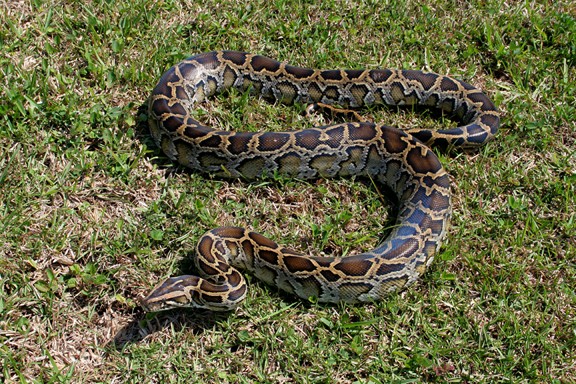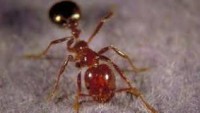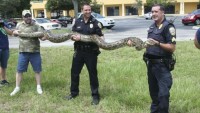Experts Track Burmese Pythons That Decimate Everglades' Native Species
| Marco Foronda | | Apr 29, 2015 10:11 AM EDT |
(Photo : National Park Service) The invasive Burmese Python caught in the Everglades in Florida
In a comprehensive tracking study on Burmese pythons in Florida, experts have identified their home range, which is important in helping them rid of the invasive species in the Everglades National Park, reports said.
The United States Geological Survey's (USGS) was able to map out the 10 thousand square-kilometer wetland in southern Florida using GPS tags, which were placed on 19 pythons caught from the park.
Like Us on Facebook
They tracked the pythons' movements for a total of 5,119 days. From the data gathered, researchers measured the species' habitat range, which is an average of 22 kilometers inside the park.
"These high-use areas may be optimal locations for control efforts and further studies on the snakes' potential impacts on native wildlife," lead researcher Kristen Hart said.
Identifying patterns of habitat use among these invasive pythons is important in creating effective strategies to control spread, Hart added.
The team found out that Burmese pythons share similar areas with other pythons in the ecosystem, where they find similar prey and prefer the same environmental conditions.
For example, it is previously known that snakes prefer to stay in a coastal habitat that is both wet and dry and places with tree islands. This survey yielded the same findings.
They also discovered that 67 percent crossed the main road, according to GPS data, but only few individuals were reported to be seen.
This proves that they are difficult to see, Hart said.
This might be the reason that the last Burmese python hunt in 2013 produced only 68 snakes from 1,600 hunters across the country.
However, experts believe that the study will help them improve this number in the next hunt.
Native to Southeast Asian countries, Burmese pythons were first recorded in the Everglades in 1979, thanks to pet trade. They lack natural predators so they can easily multiply and cause decline in other native wildlife.
Tagseverglades national park, Florida, Everglades, Burmese python, united states geological survey
©2015 Chinatopix All rights reserved. Do not reproduce without permission
EDITOR'S PICKS
-

Did the Trump administration just announce plans for a trade war with ‘hostile’ China and Russia?
-

US Senate passes Taiwan travel bill slammed by China
-

As Yan Sihong’s family grieves, here are other Chinese students who went missing abroad. Some have never been found
-

Beijing blasts Western critics who ‘smear China’ with the term sharp power
-

China Envoy Seeks to Defuse Tensions With U.S. as a Trade War Brews
-

Singapore's Deputy PM Provides Bitcoin Vote of Confidence Amid China's Blanket Bans
-

China warns investors over risks in overseas virtual currency trading
-

Chinese government most trustworthy: survey
-

Kashima Antlers On Course For Back-To-Back Titles
MOST POPULAR
LATEST NEWS
Zhou Yongkang: China's Former Security Chief Sentenced to Life in Prison

China's former Chief of the Ministry of Public Security, Zhou Yongkang, has been given a life sentence after he was found guilty of abusing his office, bribery and deliberately ... Full Article
TRENDING STORY

China Pork Prices Expected to Stabilize As The Supplies Recover

Elephone P9000 Smartphone is now on Sale on Amazon India

There's a Big Chance Cliffhangers Won't Still Be Resolved When Grey's Anatomy Season 13 Returns

Supreme Court Ruled on Samsung vs Apple Dispute for Patent Infringement

Microsoft Surface Pro 5 Rumors and Release Date: What is the Latest?












